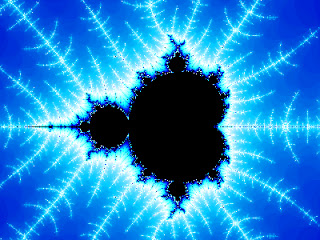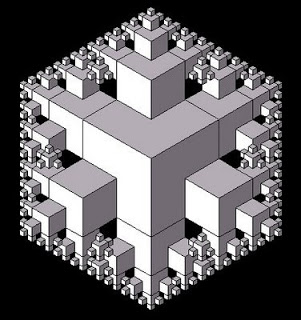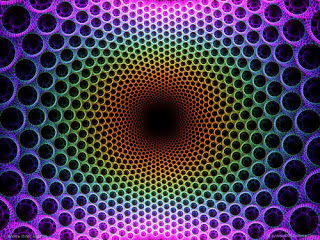Antropologia
 ?The objects we study, the objects in which we are caught up, the objects we perform, are always more than one and less than many. (?) Which is why it is interesting to work with the metaphor of the fractal. (?) A fractal is a line which occupies more than one dimension but less than two. So a fractional object? Well, this is something is indeed more than one and less than many. Somewhere in between. With is difficult to think because it defies the simplicities of the single ? but also the corresponding simplicities of pluralism of the laisez faire, of a single universe inhabited by separate objects?.
?The objects we study, the objects in which we are caught up, the objects we perform, are always more than one and less than many. (?) Which is why it is interesting to work with the metaphor of the fractal. (?) A fractal is a line which occupies more than one dimension but less than two. So a fractional object? Well, this is something is indeed more than one and less than many. Somewhere in between. With is difficult to think because it defies the simplicities of the single ? but also the corresponding simplicities of pluralism of the laisez faire, of a single universe inhabited by separate objects?.
Fonte: John Law, 1999. ?After ANT: complexity, naming and topology?. IN: Actor Network Theory and After.
 ?Fractals also make their appearance in Strathern?s texts. She comes with another fractal image: one that has to do with making parts out of a whole. Divide a thick line into two black stripes and a white stripe. So two-thirds of what you then have as your starting point is black, one third is white. Now divide each of the lines on your paper (or screen): the blacks into two black and one white line, the white into two white and one black line. And again. And again. The black and white lines get smaller and smaller. But however far you go, the amount of black and white remain the same. They only get more and more intimately included in each other. So here we have an image of a more and more ingrained mutual inclusion?
?Fractals also make their appearance in Strathern?s texts. She comes with another fractal image: one that has to do with making parts out of a whole. Divide a thick line into two black stripes and a white stripe. So two-thirds of what you then have as your starting point is black, one third is white. Now divide each of the lines on your paper (or screen): the blacks into two black and one white line, the white into two white and one black line. And again. And again. The black and white lines get smaller and smaller. But however far you go, the amount of black and white remain the same. They only get more and more intimately included in each other. So here we have an image of a more and more ingrained mutual inclusion?
Fonte: Annemarie Mol, 2002. The Body Multiple: ontology in medical practice.
 "A Geometry of Nature. The cantor dust. Begin with a line; remove the middle third; then remove the middle third of the remaining segments; and so on. The Cantor set is the dust of points that remain. They are infinitely many, but their total lenght is 0. The paradoxical qualities of such constructions disturbed nineteenth-century mathematicians, but Mandelbrot saw the Cantor set as a model for the occurence of errors in an eletronic transmission line. Engineers saw periods of error-free transmission, mixed with periods when errors would come in burst. Looked at more closely, the bursts, too, contained error-free period within them. And so on - it was an example of fractal time. At every time scale, from hours to seconds, Maldelbrot discovered that the relationship of errors to clean transmission remained constant. Such dusts, he contended, are indispensable in modeling intermittency"
"A Geometry of Nature. The cantor dust. Begin with a line; remove the middle third; then remove the middle third of the remaining segments; and so on. The Cantor set is the dust of points that remain. They are infinitely many, but their total lenght is 0. The paradoxical qualities of such constructions disturbed nineteenth-century mathematicians, but Mandelbrot saw the Cantor set as a model for the occurence of errors in an eletronic transmission line. Engineers saw periods of error-free transmission, mixed with periods when errors would come in burst. Looked at more closely, the bursts, too, contained error-free period within them. And so on - it was an example of fractal time. At every time scale, from hours to seconds, Maldelbrot discovered that the relationship of errors to clean transmission remained constant. Such dusts, he contended, are indispensable in modeling intermittency"
Fonte: Marilyn Strathern. 2004. Partial Connections.
 ?Fractal is a rough or fragmented geometric shape that can be split into parts, each of which is (at least approximately) a reduced-size copy of the whole, a property called self-similarity. Roots of mathematically rigorous treatment of fractals can be traced back to functions studied by Karl Weierstrass, Georg Cantor and Felix Hausdorff in studying functions that were continuous but not differentiable; however, the term fractal was coined by Benoît Mandelbrot in 1975 and was derived from the Latin fractus meaning "broken" or "fractured." A mathematical fractal is based on an equation that undergoes iteration, a form of feedback based on recursion.
?Fractal is a rough or fragmented geometric shape that can be split into parts, each of which is (at least approximately) a reduced-size copy of the whole, a property called self-similarity. Roots of mathematically rigorous treatment of fractals can be traced back to functions studied by Karl Weierstrass, Georg Cantor and Felix Hausdorff in studying functions that were continuous but not differentiable; however, the term fractal was coined by Benoît Mandelbrot in 1975 and was derived from the Latin fractus meaning "broken" or "fractured." A mathematical fractal is based on an equation that undergoes iteration, a form of feedback based on recursion.
A fractal often has the following features:
? It has a fine structure at arbitrarily small scales.
? It is too irregular to be easily described in traditional Euclidean geometric language.
? It is self-similar (at least approximately or stochastically).
? It has a Hausdorff dimension which is greater than its topological dimension (although this requirement is not met by space-filling curves such as the Hilbert curve).[4]
? It has a simple and recursive definition.
Because they appear similar at all levels of magnification, fractals are often considered to be infinitely complex (in informal terms). Natural objects that are approximated by fractals to a degree include clouds, mountain ranges, lightning bolts, coastlines, snow flakes, various vegetables (cauliflower and broccoli), and animal coloration patterns. However, not all self-similar objects are fractals?for example, the real line (a straight Euclidean line) is formally self-similar but fails to have other fractal characteristics; for instance, it is regular enough to be described in Euclidean terms?.
Fonte: Wikipedia (USA)
?Fractais (do latim fractus, fração, quebrado) são figuras da geometria não-Euclidiana.
 "A geometria fractal é o ramo da matemática que estuda as propriedades e comportamento dos fractais. Descreve muitas situações que não podem ser explicadas facilmente pela geometria clássica, e foram aplicadas em ciência, tecnologia e arte gerada por computador. As raízes conceituais dos fractais remontam a tentativas de medir o tamanho de objetos para os quais as definições tradicionais baseadas na geometria euclidiana falham.
"A geometria fractal é o ramo da matemática que estuda as propriedades e comportamento dos fractais. Descreve muitas situações que não podem ser explicadas facilmente pela geometria clássica, e foram aplicadas em ciência, tecnologia e arte gerada por computador. As raízes conceituais dos fractais remontam a tentativas de medir o tamanho de objetos para os quais as definições tradicionais baseadas na geometria euclidiana falham.
Um fractal (anteriormente conhecido como curva monstro) é um objeto geométrico que pode ser dividido em partes, cada uma das quais semelhante ao objeto original. Diz-se que os fractais têm infinitos detalhes, são geralmente autossimilares e independem de escala. Em muitos casos um fractal pode ser gerado por um padrão repetido, tipicamente um processo recorrente ou iterativo.
O termo foi criado em 1975 por Benoît Mandelbrot, matemático francês nascido na Polónia, que descobriu a geometria fractal na década de 1970 do século XX, a partir do adjetivo latino fractus, do verbo frangere, que significa quebrar?.
Fonte: Wikipedia (Brasil)
- Metalogue: Why A Swan? - Bateson
"Daughter: why a swan? Father: Yes - and why a puppet in Petroushka? D: No - that's different. After all a puppet is sort of human - and that particular puppet is very human. F: More human then people? D: Yes. F: But still only sort of human? And...
- Ontological Politics - Annemarie Mol
"These have to do with ontological politics. They have to do with the way in which 'the real' is implicated in the political and vice versa.(...) Ontological Politics is a composite term. It talks of ontology - which in standart philosophical...
- Bateson - "body-in-the-environment"
"We commonly think of the external 'physical world' as somehow separate from an internal 'mental world'. I believe that this division is based on the contrast in coding and transmission inside and outside the body. (...)In considering...
- Novidades Na Biblioteca Antroposimétrica!
Novos Textos Foram disponibilizados na biblioteca antroposimétrica (acessar no link ao lado): Indigenous Knowledge and western science: the possibility of dialogue - Bala e Joseph Humains et non-humains: un bilan d'etape de la sociologie des collectifs...
- Novidades Na Biblioteca Antroposimetrica
Foram disponibilizados novos artigos na bilioteca: The Animal That There for I am - Jacques Derrida The Subject and Power - Michel Foucault Ritual as Comunication: Order, Meaning, and Secrecy in Melanesian Initiation Rites - R. Wagner Knowing and Believing:...
Antropologia
Sobre Fractais (About Fractals)...

Fonte: John Law, 1999. ?After ANT: complexity, naming and topology?. IN: Actor Network Theory and After.

Fonte: Annemarie Mol, 2002. The Body Multiple: ontology in medical practice.

Fonte: Marilyn Strathern. 2004. Partial Connections.

A fractal often has the following features:
? It has a fine structure at arbitrarily small scales.
? It is too irregular to be easily described in traditional Euclidean geometric language.
? It is self-similar (at least approximately or stochastically).
? It has a Hausdorff dimension which is greater than its topological dimension (although this requirement is not met by space-filling curves such as the Hilbert curve).[4]
? It has a simple and recursive definition.
Because they appear similar at all levels of magnification, fractals are often considered to be infinitely complex (in informal terms). Natural objects that are approximated by fractals to a degree include clouds, mountain ranges, lightning bolts, coastlines, snow flakes, various vegetables (cauliflower and broccoli), and animal coloration patterns. However, not all self-similar objects are fractals?for example, the real line (a straight Euclidean line) is formally self-similar but fails to have other fractal characteristics; for instance, it is regular enough to be described in Euclidean terms?.
Fonte: Wikipedia (USA)
?Fractais (do latim fractus, fração, quebrado) são figuras da geometria não-Euclidiana.

Um fractal (anteriormente conhecido como curva monstro) é um objeto geométrico que pode ser dividido em partes, cada uma das quais semelhante ao objeto original. Diz-se que os fractais têm infinitos detalhes, são geralmente autossimilares e independem de escala. Em muitos casos um fractal pode ser gerado por um padrão repetido, tipicamente um processo recorrente ou iterativo.
O termo foi criado em 1975 por Benoît Mandelbrot, matemático francês nascido na Polónia, que descobriu a geometria fractal na década de 1970 do século XX, a partir do adjetivo latino fractus, do verbo frangere, que significa quebrar?.
Fonte: Wikipedia (Brasil)
loading...
- Metalogue: Why A Swan? - Bateson
"Daughter: why a swan? Father: Yes - and why a puppet in Petroushka? D: No - that's different. After all a puppet is sort of human - and that particular puppet is very human. F: More human then people? D: Yes. F: But still only sort of human? And...
- Ontological Politics - Annemarie Mol
"These have to do with ontological politics. They have to do with the way in which 'the real' is implicated in the political and vice versa.(...) Ontological Politics is a composite term. It talks of ontology - which in standart philosophical...
- Bateson - "body-in-the-environment"
"We commonly think of the external 'physical world' as somehow separate from an internal 'mental world'. I believe that this division is based on the contrast in coding and transmission inside and outside the body. (...)In considering...
- Novidades Na Biblioteca Antroposimétrica!
Novos Textos Foram disponibilizados na biblioteca antroposimétrica (acessar no link ao lado): Indigenous Knowledge and western science: the possibility of dialogue - Bala e Joseph Humains et non-humains: un bilan d'etape de la sociologie des collectifs...
- Novidades Na Biblioteca Antroposimetrica
Foram disponibilizados novos artigos na bilioteca: The Animal That There for I am - Jacques Derrida The Subject and Power - Michel Foucault Ritual as Comunication: Order, Meaning, and Secrecy in Melanesian Initiation Rites - R. Wagner Knowing and Believing:...
